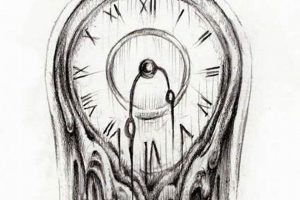Representations of musical passion through body art encompass a wide range of possibilities, from minimalist symbols like notes and clefs to elaborate portraits of beloved musicians or intricate depictions of instruments. Examples include single-line drawings of treble clefs, realistic depictions of guitars, or stylized representations of sound waves.
These artistic expressions can serve as powerful reminders of personal connections to specific songs, genres, or artists. They can symbolize a lifelong dedication to music, commemorate a significant musical experience, or simply showcase an individual’s aesthetic appreciation for musical elements. Historically, musical iconography has held cultural significance, with instruments and symbols appearing in various art forms. Body art provides a contemporary canvas for these enduring symbols.
Exploring the breadth of potential designs provides an opportunity to delve into the diverse ways individuals choose to express their musical identities. Consideration will be given to factors such as stylistic preferences, symbolic meanings, and placement on the body.
1. Genre
Musical genre significantly influences the stylistic direction of a tattoo design. The visual language employed often reflects the genre’s associated aesthetics and cultural connotations. For example, the bold, aggressive lines characteristic of thrash metal album art might inspire a similarly styled tattoo, while the flowing, organic forms associated with psychedelic rock could translate into a softer, more intricate design. The choice of genre provides a framework for the overall artistic approach.
This connection extends beyond mere aesthetics. Genre often embodies specific values and philosophies. A tattoo inspired by classical music might emphasize precision and elegance through clean lines and meticulous detail, reflecting the genre’s emphasis on formal structure. Conversely, a punk rock-inspired tattoo might embrace a DIY aesthetic with rough lines and bold colors, echoing the genre’s rebellious spirit. Understanding these underlying principles allows for a more profound and authentic representation of one’s musical identity.
Effective communication of musical preferences through tattoo design necessitates careful consideration of genre conventions. While stylistic interpretations can be highly personalized, adhering to certain genre-specific visual cues can enhance clarity and resonance. Challenges arise when attempting to blend disparate genres, requiring a nuanced approach to balance competing aesthetics. Ultimately, a successful design harmonizes personal expression with the genre’s established visual language.
2. Instrument
Instrument choice constitutes a core element within music-themed tattoo designs. Depictions of instruments serve as visual shorthand for broader musical affinities, often representing a specific genre, skill set, or emotional connection. The instrument becomes a symbol of the individual’s relationship with music itself.
- Visual Representation
Instruments offer diverse visual possibilities, ranging from highly detailed, photorealistic renderings to stylized, minimalist outlines. A complex depiction of a vintage saxophone might showcase appreciation for jazz and its historical context, while a simple line drawing of a ukulele could evoke a sense of lightheartedness and informality. The chosen style significantly impacts the tattoo’s overall aesthetic.
- Personal Significance
The selection of a specific instrument often reflects a deeply personal connection. A musician might choose to immortalize their primary instrument as a testament to their dedication and craft. Alternatively, an individual might choose an instrument that represents a formative musical experience, such as the first instrument they learned to play or one associated with a cherished memory. These personal narratives imbue the tattoo with deeper meaning.
- Symbolic Resonance
Certain instruments carry symbolic weight beyond their musical function. A harp might represent celestial harmony, while a drum could symbolize primal rhythm and energy. These broader cultural associations add layers of interpretation to the tattoo, enhancing its symbolic richness. Incorporating these symbolic elements allows for a more nuanced and layered design.
- Compositional Elements
The depiction of an instrument provides strong compositional elements within a tattoo design. The instrument’s shape and form can be used to create visual flow and balance. It can serve as a focal point or be integrated with other elements, such as musical notes or lyrics, to create a more complex and dynamic composition. Understanding these compositional principles is crucial for a cohesive and visually appealing design.
Ultimately, the choice of instrument depicted in a music-themed tattoo functions as a powerful statement of musical identity. By carefully considering the instrument’s visual representation, personal significance, symbolic resonance, and compositional potential, individuals can create a tattoo that authentically reflects their unique relationship with music. This careful selection ensures a design that resonates both visually and emotionally.
3. Lyrics
Lyrics, the textual component of songs, provide a rich source of inspiration for music-themed tattoos. Representing the narrative, emotional core, or thematic essence of a musical piece, lyrical excerpts can encapsulate deeply personal connections to music. Their inclusion in tattoo designs offers a powerful means of expressing individual interpretations and resonant experiences. From single words to complete verses, lyrics provide a diverse palette for creative expression within the realm of body art.
- Emotional Resonance
Lyrics often articulate emotions and experiences that resonate deeply with individuals. A line from a song that provided solace during a difficult time, or one that embodies a personal philosophy, can be transformed into a permanent reminder of its significance. For instance, a line about resilience might symbolize overcoming personal challenges. The emotional weight carried by these words elevates the tattoo beyond mere aesthetics, imbuing it with personal meaning.
- Narrative Significance
Song lyrics frequently weave narratives, telling stories that capture universal themes or personal journeys. Incorporating these narrative fragments into a tattoo can serve as a visual representation of a specific chapter in one’s life or a broader philosophical perspective. A line from a song about travel could commemorate a significant journey, while a lyric about societal change might reflect one’s activist values. These narrative elements provide context and depth to the tattoo design.
- Typographic Considerations
The visual presentation of lyrics plays a crucial role in the overall aesthetic of the tattoo. Font selection, size, and placement contribute significantly to the design’s impact. A delicate script font might be suitable for a romantic lyric, while a bold, blocky font could emphasize a powerful message. The typographic choices should complement the lyrical content and the individual’s personal style, creating a harmonious visual composition.
- Contextual Interpretation
The meaning of lyrics can evolve over time, both within the broader cultural context and within the individual’s personal narrative. A lyric that held one meaning during adolescence might take on new significance in adulthood. This dynamic interpretation allows the tattoo to remain relevant and resonant throughout life, adapting to the individual’s evolving understanding of the lyrics and their personal experiences.
By carefully considering the emotional resonance, narrative significance, typographic elements, and potential for contextual interpretation, individuals can leverage the power of lyrics to create deeply meaningful music-themed tattoos. These textual elements offer a potent means of self-expression, allowing individuals to showcase their unique connection to music through the words that resonate most profoundly with their personal experiences and values. The selection and presentation of lyrics contribute significantly to the tattoo’s overall artistic and personal impact.
4. Artist
The “Artist” represents a pivotal element within music-themed tattoo designs, extending beyond mere fandom to encompass broader artistic and personal influences. Portraits of musicians can symbolize admiration for their creative output, embody specific musical eras or genres, or reflect deeply personal connections to their work. Consideration of an artist’s visual aesthetic, musical contribution, and personal significance informs design choices and imbues the tattoo with layered meaning. A portrait of David Bowie, for example, might symbolize artistic innovation and androgynous self-expression, while a depiction of Johnny Cash could represent outlaw country and a rebellious spirit.
Representing specific artists visually requires careful consideration of stylistic choices. Photorealistic portraits capture intricate details and likeness, showcasing technical skill and dedication. Abstract or stylized representations prioritize symbolic elements and artistic interpretation, offering a more personalized aesthetic. The chosen style should reflect the artist’s visual identity and the individual’s personal aesthetic preferences. A minimalist line drawing of Freddie Mercury might emphasize his dynamic stage presence, while a detailed portrait of Amy Winehouse could highlight her distinctive vocal style and vulnerability. Practical considerations include the tattoo artist’s skill level, available canvas space, and desired level of detail.
Ultimately, incorporating an artist into a music-themed tattoo design serves as a visual tribute to their creative legacy and its impact on the individual. It allows for a public declaration of musical influence, demonstrating a deep appreciation for the artist’s work and its role in shaping personal identity. However, its important to acknowledge the potential for evolving musical tastes and artistic preferences. Careful consideration of the artist’s lasting significance and their enduring influence on the individual can mitigate the risk of future regret. Choosing an artist whose work has consistently resonated throughout one’s life ensures a design that remains meaningful over time.
5. Symbolism
Symbolic representation forms an integral layer within music-themed tattoo designs, offering a concise visual language for expressing complex musical concepts and personal connections. Beyond literal depictions of instruments or artists, symbolic elements provide a deeper, more nuanced way to communicate one’s musical identity. These symbols can represent abstract concepts like rhythm, harmony, or musical passion, allowing for a more personalized and layered expression.
- Musical Notation
Elements of musical notation, such as clefs, notes, and rests, serve as fundamental symbols within music-themed tattoos. A treble clef can signify a connection to higher registers and melodic lines, while a bass clef might represent a grounding in rhythm and lower frequencies. These symbols can be incorporated in various styles, from simple line drawings to more elaborate, ornamental designs. A single, elegantly drawn treble clef might symbolize a lifelong dedication to music, while a series of notes forming a melody could represent a specific song or musical phrase.
- Abstract Representations
Abstract symbols offer a wider range of interpretations and can be used to represent more complex musical concepts. A spiral, for example, might symbolize the cyclical nature of musical phrases or the evolution of musical genres. Geometric patterns can represent the mathematical underpinnings of music theory, while stylized depictions of sound waves can evoke the physical properties of sound. These abstract symbols allow for greater creative freedom and personalized meaning, enabling individuals to express their unique understanding and experience of music.
- Cultural and Spiritual Symbols
Music often intersects with broader cultural and spiritual traditions, resulting in a rich tapestry of symbolic associations. Certain instruments, such as the Celtic harp or the Native American flute, carry deep cultural significance. Symbols from various spiritual traditions, such as mandalas or Om symbols, can be incorporated to represent the transcendent and meditative qualities of music. These cultural and spiritual symbols add layers of meaning and context to the tattoo, reflecting the individual’s broader worldview and beliefs.
- Personal Emblems
Beyond established musical symbols, individuals can create personalized emblems that hold unique significance. These might be based on specific songs, albums, or musical experiences. A stylized representation of a concert ticket stub could commemorate a significant musical event, while an abstract design inspired by a particular album cover could represent a formative period in one’s musical journey. These personalized symbols allow for a deeper level of self-expression, reflecting the individual’s unique relationship with music.
Through the thoughtful incorporation of symbolic elements, music-themed tattoos transcend mere aesthetic decoration and become powerful statements of musical identity. These symbols, ranging from traditional musical notation to personalized emblems, provide a concise yet nuanced visual language for expressing one’s deepest connections to music. Careful selection and placement of these symbols allow individuals to create tattoos that resonate both visually and emotionally, reflecting their unique musical journeys and experiences.
Tips for Music Tattoo Ideas
Careful planning ensures a music-themed tattoo remains a source of personal pride and aesthetic satisfaction. Consideration of practical and artistic elements contributes significantly to the final design’s success.
Tip 1: Research Thoroughly
Extensive research should precede any permanent body art. Exploring various artistic styles, symbolic representations, and placement options ensures informed decision-making. Consulting with experienced tattoo artists provides valuable insights into design feasibility and technical considerations. Thorough preparation minimizes the potential for regret and maximizes the likelihood of a successful outcome.
Tip 2: Prioritize Meaningful Designs
A music-themed tattoo should resonate deeply with the individual’s musical identity and personal narrative. Opting for designs that hold genuine significance, rather than following fleeting trends, ensures enduring relevance and personal satisfaction. A tattoo commemorating a formative concert experience, for example, holds greater personal value than a generic musical symbol.
Tip 3: Consider Placement Carefully
Tattoo placement impacts both visibility and aesthetic integration with the body’s natural contours. Factors such as size, complexity, and desired level of discretion influence placement choices. A small, minimalist design might be suitable for the wrist, while a larger, more intricate piece might be better suited for the back or chest. Placement should complement the design and enhance its overall impact.
Tip 4: Collaborate with a Skilled Artist
Selecting a reputable and experienced tattoo artist specializing in the desired style is crucial. Reviewing portfolios and seeking recommendations helps ensure artistic compatibility and technical proficiency. Open communication with the chosen artist facilitates a collaborative design process, resulting in a tattoo that meets the individual’s expectations.
Tip 5: Plan for Long-Term Care
Proper aftercare ensures the tattoo heals correctly and retains its vibrancy over time. Following the artist’s instructions regarding cleaning, moisturizing, and sun protection is essential for preserving the tattoo’s integrity and preventing complications. Commitment to long-term care maintains the tattoo’s aesthetic appeal and prevents premature fading or discoloration.
Tip 6: Embrace the Evolution of Musical Tastes
Musical preferences can evolve over time. Selecting designs that represent enduring musical influences rather than fleeting trends mitigates the risk of future dissatisfaction. Focusing on core musical values and foundational experiences provides a more stable basis for a tattoo design that remains personally relevant over time.
By adhering to these guidelines, individuals can ensure their music-themed tattoos remain powerful and meaningful expressions of their musical identities. Careful planning and thoughtful consideration contribute significantly to a tattoo’s lasting impact and personal resonance.
These tips serve as a roadmap for navigating the creative process of designing a music-themed tattoo, culminating in a piece of body art that resonates deeply with personal values and artistic expression. The subsequent conclusion will synthesize these insights and offer final recommendations.
Frequently Asked Questions
Addressing common inquiries regarding music-themed tattoo designs provides clarity and facilitates informed decision-making. These responses offer practical guidance and address potential concerns.
Question 1: How does one select an appropriate musical symbol for a tattoo?
Symbol selection should reflect personal musical experiences and preferences. A symbol’s cultural and historical context should also be considered. Researching various musical symbols and their associated meanings ensures informed choices.
Question 2: What factors influence the cost of a music-themed tattoo?
Cost depends on factors such as size, complexity, artist’s experience, and geographic location. Detailed, intricate designs require more time and skill, thus increasing cost. Obtaining quotes from multiple artists allows for cost comparison and informed budgeting.
Question 3: Can musical notation be effectively incorporated into tattoo designs?
Musical notation lends itself well to tattoo art. Elements like clefs, notes, and staffs can be stylized or rendered realistically. Placement and size considerations ensure visual harmony and readability.
Question 4: What are the best placement options for music-themed tattoos?
Optimal placement depends on design size and personal preference. The forearm, upper arm, back, and ribs offer larger canvas areas for intricate designs. Smaller, minimalist designs can be placed on the wrist, ankle, or behind the ear. Visibility and pain tolerance should also be considered.
Question 5: How does one find a reputable tattoo artist specializing in music-themed designs?
Recommendations from other music enthusiasts, online portfolio reviews, and consultations with local tattoo studios can help identify skilled artists. Assessing an artist’s experience with similar designs and discussing design ideas ensures compatibility.
Question 6: What long-term care practices ensure a music-themed tattoo retains its vibrancy?
Protecting the tattoo from excessive sun exposure, using appropriate moisturizing products, and avoiding harsh chemicals preserves color vibrancy. Following the artist’s aftercare instructions is crucial for proper healing and long-term maintenance.
Careful consideration of these frequently asked questions enables informed decisions regarding music-themed tattoo designs. Prioritizing personal meaning, artistic quality, and long-term care ensures lasting satisfaction with the chosen design.
The following conclusion summarizes key insights and offers final recommendations for those considering a music-themed tattoo.
Conclusion
Exploration of music-themed tattoo designs reveals a rich tapestry of personal expression and artistic interpretation. Careful consideration of genre, instrument, lyrics, artist portrayal, and symbolic representation ensures a design that resonates deeply with individual musical identities. Practical considerations, including artist selection, placement, and long-term care, contribute significantly to a tattoo’s lasting impact and aesthetic integrity.
Music’s profound influence on personal narratives finds powerful expression through the art of tattooing. Thoughtful design choices transform ephemeral musical experiences into enduring visual testaments. A well-crafted music-themed tattoo serves not merely as body art, but as a tangible embodiment of one’s lifelong connection to music.







